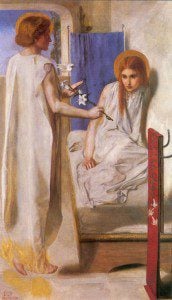
In Hinduism, bhakti is a mystical path focused on intense love of the divine in the form of one of the gods. Bhakti is radical devotion to a god or goddess in order to achieve spiritual enlightenment through love.
In modern paganism, something similar to bhakti has been developing organically through the practice of devotion to the gods of the old pagan pantheons. This wasn’t very common until fairly recently, and it seems to have started spontaneously, outside of any formal neopagan tradition. Worshipers report being chosen to serve and devote themselves to a particular deity, a process that can sometimes be surprising or even upsetting to the chosen devotee.
The usual pattern seems to be that a deity compels the worshipers’ attention through repeated appearances in dreams or by other means until the worshiper becomes a formal devotee or priest of that deity. Some refer to themselves as being “god-owned” or even “god-spouses,” while others refer to themselves as the “hands” of the deity on earth. Some devotees report a give-and-take relationship with the god in which they carry out the deity’s wishes or requests in exchange for help with their own problems. Others report a relationship of almost all-encompassing service and devotion, in which they may even be expected to reorder their lives completely in order to center everything on the deity.
As strange as this might seem to anyone who hasn’t been commanded to serve a god in this way, it has the potential to be a genuine mystical practice. What do I mean by that?
According to Albert Einstein:
The most beautiful and profound emotion we can experience is the sensation of the mystical. He to whom this emotion is a stranger, who can no longer wonder and stand rapt in awe, is as good as dead. To know that what is impenetrable to us really exists, manifesting itself as the highest wisdom and the most radiant beauty, which our dull faculties can comprehend only in their primitive forms – this knowledge, this feeling, is at the center of true religion.
This description captures some of the essential emotional features of genuine mysticism- wonder, awe, wisdom and radiant beauty. The mystical experience goes far beyond emotion, but the distinctive feature of bhakti practice is that it uses intense emotion to reach the mystical experience. Rather than stilling emotions, ideas and other mental activities as in Zen, bhakti focuses them all as intensely as possible on the presence of the beloved deity, so that the passionate love of the deity carries the worshiper through to the mystical experience on a wave of ecstatic joy:
Alone with the spark of my longing
I lay beside you on the floor,
In the shape of a girl I had just met,
Yet not a girl toward whom I had intentions.
You were kind enough not to mention
The inherent tension of the situation.
For a long time, we only talked.
Then you stretched out your legs
And let them rest on mine,
Making my breath catch
In my chest like a fish caught
Up short on a sharp hook,
Jerked out of the water to blink in terror,
Staring blindly at the blazing sun.“Get some sleep,” you said,
But instead I woke up.
There was a steadily growing
Glow behind my eyelids,
Behind the world.
I saw a madman staring,
His hair disheveled.
He had the fixed, crazed gaze
Of a weird prophet
With matted beard.
His eyes darted from one thing
To another with a fervent fury
As if in a hurry
To burst out screaming.“You are not simply dreaming,”
Said a voice in my ear.
“She is everywhere.
She is here!
She has allowed you to lie
Beside her and have words
With her as you would a friend,
And now she shows you
How it is at the end:
That there is nothing in anything
But a blazing beauty,
That there is nothing in anything
But forever’s fire.
That there is nothing in anything
But Her desire,
Expanding out from Herself
Like a splitting atom.“There is no matter
There is no spirit
There is no body
There is no mind.
There is nothing,
No nothing
That you can find.
There is only Her!
There is only Her!
There is only Her!
There is only Her!”
Rather than talking in a hypothetical way about what the mystical experience actually is, I’m going to talk about how to get there yourself through your own relationship with the gods and goddesses you personally serve. This is not an attempt to import something like bhakti from Hinduism into modern western paganism, because devotional practice to specific deities is already naturally developing within the pagan revival. However, I will be using the concept of bhakti as an analogy for the most intense and mystical forms of modern devotional paganism, such as the mood expressed in this poem.
Modern paganism is not simply a revival of the ancient pagan religions, but was there anything like this practice in ancient times? The answer is yes. The devotees of the Phrygian goddess Cybele were known for the extreme fervor of their ecstatic devotion to her. The philosopher Iamblichus and his followers based their entire spiritual practice on “theurgy,” the use of ritual to invoke the gods, experience divine possession and approach mystical unity through that experience.
Finally, there is a hint of personal devotional practice in certain ancient Celtic names, such as my own religious name “Gilbride,” meaning “Servant of Brighid.” We’ll discuss these names further in part 2.
Loop of Brighid is published on alternate Thursdays. Follow it via RSS or e-mail!

















